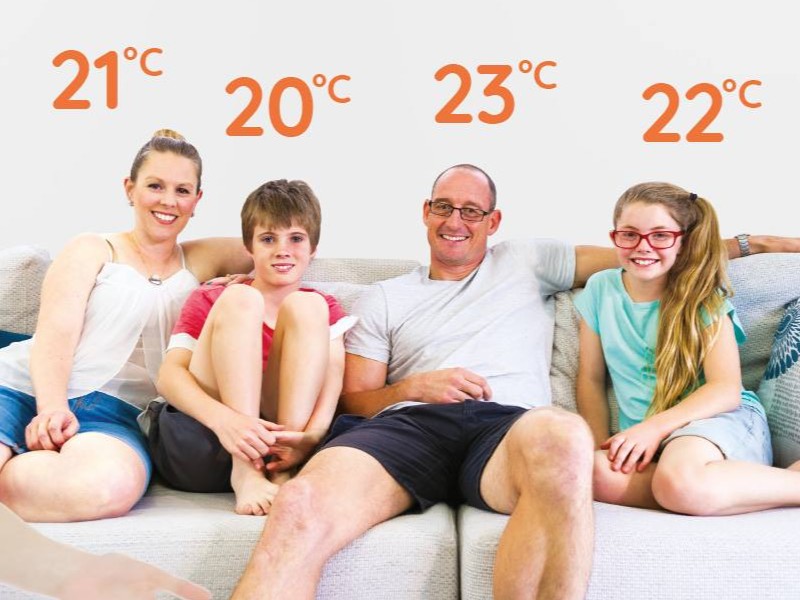Temperature Sensors for your Ducted Air Conditioner
Ducted Air Conditioning is no longer a luxury – it’s fast becoming the standard in modern homes.
As the technology evolves, so do the smart features that come with it. One standout innovation is the use of temperature sensors.
In this blog, we’ll dive into:


What are Ducted Air Conditioning Temperature Sensors?
All Ducted Reverse Cycle Air Conditioners and Gas Ducted Heaters come with one temperature sensor – your wall controller.
This sensor acts as the system’s thermostat, monitoring the ambient temperature in the area where the controller is installed.
When you set your preferred temperature – whether via the wall controller or remotely through an app (if your system has Wi-Fi control) – the sensor in the controller keeps track of the room’s temperature.
Once your desired temperature is reached, the system automatically adjusts its output. Instead of running at full capacity, it switches to a reduced energy consumption mode, working just enough to keep the room comfortable without wasting energy.
Why install additional Sensors?
Relying on a single sensor – your wall controller – can lead to uneven temperatures throughout your home.
That’s where additional temperature sensors come in.
By installing additional sensors, your system gains a much clearer picture of the actual conditions in each area. It can then adjust airflow or temperature settings to better balance comfort across your entire home – not just near the wall controller.
However, you need to have Zoning set up in order to benefit from Temperature Sensors.
Why do you need Zoning to use Temperature Sensors?
To take full advantage of temperature sensors, your ducted system needs to be set up with Zoning.
Zoning groups your rooms into separate areas (or “Zones”) which can be controlled independently, allowing you to turn Zones on and off as required, so you’re not heating or cooling rooms you aren’t using.
Without Zoning, your system operates based on a single temperature reading. And even if you add sensors in other rooms, the system won’t be able to do much with that information, as Zoning is controlled by Zone motors installed in your ducts which control how much air goes into each room.
Zoning is a must-have when it comes to energy efficiency and an optional extra we highly recommend. Not only does it help you cut down on running costs, but when paired with temperature sensors, it gives you complete, room-by-room control over your home’s climate. It’s comfort, control, and savings all rolled into one smart solution.
Temperature Sensor benefits:
Can I add Temperature Sensors to my existing system?
Temperature Sensors connect directly to your wall controller, so it’s important to use sensors that are compatible with the controller you’ve installed — typically from the same manufacturer.
You might choose to stick with your air conditioner brand’s native controller, such as Rinnai, Brivis, Daikin, Mitsubishi, or ActronAir. Alternatively, you can opt for a third-party smart controller that offers more advanced features.
One of our most popular choices is AirTouch 5 – an intelligent control system that works with all major ducted air conditioner brands. It features a sleek touchscreen wall controller, Wi-Fi app control, geofencing, and the option to add temperature sensors for even greater comfort and efficiency.
How many Sensors do I need?
For optimal performance and comfort, installing one temperature sensor per Zone is ideal. This setup allows your system to monitor and adjust the temperature in each individual area of your home, ensuring consistent comfort and improved energy efficiency.
However, it’s not always necessary to install a sensor in every Zone. Some homeowners choose a more selective approach. For example, in a double-storey home, it’s common to install a sensor upstairs, where heat tends to rise and rooms can become warmer than those on the ground floor. This allows the system to more accurately regulate temperature where it’s most needed.
Ultimately, the number of sensors you install depends on your budget, the layout of your home, and how precise you want your climate control to be.

Need more info?
Get in touch – call and talk to one of our qualified tradespeople, or use our easy online quote request form.
We specialise in ducted heating and cooling systems and either can provide you with a quote to install a new system, or to add temperature sensors to your exisiting system.
Learn more about Ducted Air Conditioning systems or Gas Ducted Heaters

